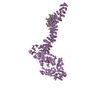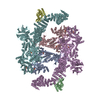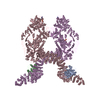[English] 日本語
 Yorodumi
Yorodumi- PDB-8fo8: Cryo-EM structure of Rab29-LRRK2 complex in the LRRK2 dimer state -
+ Open data
Open data
- Basic information
Basic information
| Entry | Database: PDB / ID: 8fo8 | ||||||
|---|---|---|---|---|---|---|---|
| Title | Cryo-EM structure of Rab29-LRRK2 complex in the LRRK2 dimer state | ||||||
 Components Components |
| ||||||
 Keywords Keywords | HYDROLASE / Cryo-EM / Parkinson's disease / Kinase / LRRK2 / Rab GTPases / Activation | ||||||
| Function / homology |  Function and homology information Function and homology informationprotein localization to ciliary membrane / peroxidase inhibitor activity / caveola neck / negative regulation of thioredoxin peroxidase activity by peptidyl-threonine phosphorylation / negative regulation of protein processing involved in protein targeting to mitochondrion / Wnt signalosome assembly / phagosome-lysosome fusion / beta-catenin destruction complex binding / regulation of branching morphogenesis of a nerve / regulation of kidney size ...protein localization to ciliary membrane / peroxidase inhibitor activity / caveola neck / negative regulation of thioredoxin peroxidase activity by peptidyl-threonine phosphorylation / negative regulation of protein processing involved in protein targeting to mitochondrion / Wnt signalosome assembly / phagosome-lysosome fusion / beta-catenin destruction complex binding / regulation of branching morphogenesis of a nerve / regulation of kidney size / regulation of neuron maturation / tangential migration from the subventricular zone to the olfactory bulb / protein localization to endoplasmic reticulum exit site / GTP-dependent protein kinase activity / regulation of neuroblast proliferation / regulation of ER to Golgi vesicle-mediated transport / negative regulation of late endosome to lysosome transport / regulation of synaptic vesicle transport / regulation of mitochondrial depolarization / negative regulation of protein targeting to mitochondrion / positive regulation of dopamine receptor signaling pathway / regulation of lysosomal lumen pH / regulation of CAMKK-AMPK signaling cascade / amphisome / mitochondrion localization / cytoplasmic side of mitochondrial outer membrane / co-receptor binding / modulation by host of viral process / regulation of retrograde transport, endosome to Golgi / negative regulation of excitatory postsynaptic potential / regulation of dopamine receptor signaling pathway / negative regulation of autophagosome assembly / positive regulation of microglial cell activation / neuron projection arborization / positive regulation of synaptic vesicle endocytosis / JUN kinase kinase kinase activity / olfactory bulb development / RAB geranylgeranylation / regulation of protein kinase A signaling / positive regulation of intracellular protein transport / multivesicular body, internal vesicle / striatum development / melanosome organization / regulation of dendritic spine morphogenesis / protein localization to mitochondrion / cellular response to dopamine / protein localization to membrane / cis-Golgi network / presynaptic cytosol / positive regulation of protein autoubiquitination / endoplasmic reticulum organization / retrograde transport, endosome to Golgi / cellular detoxification / positive regulation of programmed cell death / Wnt signalosome / regulation of canonical Wnt signaling pathway / GTP metabolic process / negative regulation of protein processing / vacuole / syntaxin-1 binding / regulation of reactive oxygen species metabolic process / negative regulation of GTPase activity / exploration behavior / autolysosome / regulation of locomotion / protein kinase A binding / Golgi-associated vesicle / neuromuscular junction development / regulation of synaptic vesicle exocytosis / PTK6 promotes HIF1A stabilization / clathrin binding / negative regulation of macroautophagy / dynein complex binding / positive regulation of receptor recycling / intracellular vesicle / regulation of mitochondrial fission / lysosome organization / intracellular distribution of mitochondria / endosome to lysosome transport / positive regulation of T cell receptor signaling pathway / positive regulation of nitric-oxide synthase biosynthetic process / locomotory exploration behavior / Golgi organization / kinesin binding / endoplasmic reticulum exit site / microvillus / Rho protein signal transduction / MAP kinase kinase kinase activity / positive regulation of protein kinase activity / canonical Wnt signaling pathway / cellular response to manganese ion / endomembrane system / positive regulation of autophagy / negative regulation of endoplasmic reticulum stress-induced intrinsic apoptotic signaling pathway / JNK cascade / regulation of synaptic transmission, glutamatergic / synapse assembly / T cell activation / dendrite cytoplasm / excitatory postsynaptic potential Similarity search - Function | ||||||
| Biological species |  Homo sapiens (human) Homo sapiens (human) | ||||||
| Method | ELECTRON MICROSCOPY / single particle reconstruction / cryo EM / Resolution: 3.88 Å | ||||||
 Authors Authors | Zhu, H. / Sun, J. | ||||||
| Funding support |  United States, 1items United States, 1items
| ||||||
 Citation Citation |  Journal: Science / Year: 2023 Journal: Science / Year: 2023Title: Rab29-dependent asymmetrical activation of leucine-rich repeat kinase 2. Authors: Hanwen Zhu / Francesca Tonelli / Martin Turk / Alan Prescott / Dario R Alessi / Ji Sun /   Abstract: Gain-of-function mutations in , which encodes the leucine-rich repeat kinase 2 (LRRK2), are the most common genetic cause of late-onset Parkinson's disease. LRRK2 is recruited to membrane organelles ...Gain-of-function mutations in , which encodes the leucine-rich repeat kinase 2 (LRRK2), are the most common genetic cause of late-onset Parkinson's disease. LRRK2 is recruited to membrane organelles and activated by Rab29, a Rab guanosine triphosphatase encoded in the locus. We present cryo-electron microscopy structures of Rab29-LRRK2 complexes in three oligomeric states, providing key snapshots during LRRK2 recruitment and activation. Rab29 induces an unexpected tetrameric assembly of LRRK2, formed by two kinase-active central protomers and two kinase-inactive peripheral protomers. The central protomers resemble the active-like state trapped by the type I kinase inhibitor DNL201, a compound that underwent a phase 1 clinical trial. Our work reveals the structural mechanism of LRRK2 spatial regulation and provides insights into LRRK2 inhibitor design for Parkinson's disease treatment. #1:  Journal: bioRxiv / Year: 2022 Journal: bioRxiv / Year: 2022Title: Structural basis of human LRRK2 membrane recruitment and activation Authors: Zhu, H. / Tonelli, F. / Alessi, D. / Sun, J. | ||||||
| History |
|
- Structure visualization
Structure visualization
| Structure viewer | Molecule:  Molmil Molmil Jmol/JSmol Jmol/JSmol |
|---|
- Downloads & links
Downloads & links
- Download
Download
| PDBx/mmCIF format |  8fo8.cif.gz 8fo8.cif.gz | 820.9 KB | Display |  PDBx/mmCIF format PDBx/mmCIF format |
|---|---|---|---|---|
| PDB format |  pdb8fo8.ent.gz pdb8fo8.ent.gz | 655.5 KB | Display |  PDB format PDB format |
| PDBx/mmJSON format |  8fo8.json.gz 8fo8.json.gz | Tree view |  PDBx/mmJSON format PDBx/mmJSON format | |
| Others |  Other downloads Other downloads |
-Validation report
| Summary document |  8fo8_validation.pdf.gz 8fo8_validation.pdf.gz | 1.5 MB | Display |  wwPDB validaton report wwPDB validaton report |
|---|---|---|---|---|
| Full document |  8fo8_full_validation.pdf.gz 8fo8_full_validation.pdf.gz | 1.5 MB | Display | |
| Data in XML |  8fo8_validation.xml.gz 8fo8_validation.xml.gz | 131.9 KB | Display | |
| Data in CIF |  8fo8_validation.cif.gz 8fo8_validation.cif.gz | 201.1 KB | Display | |
| Arichive directory |  https://data.pdbj.org/pub/pdb/validation_reports/fo/8fo8 https://data.pdbj.org/pub/pdb/validation_reports/fo/8fo8 ftp://data.pdbj.org/pub/pdb/validation_reports/fo/8fo8 ftp://data.pdbj.org/pub/pdb/validation_reports/fo/8fo8 | HTTPS FTP |
-Related structure data
| Related structure data |  29341MC  8fo2C  8fo9C  8smcC M: map data used to model this data C: citing same article ( |
|---|---|
| Similar structure data | Similarity search - Function & homology  F&H Search F&H Search |
- Links
Links
- Assembly
Assembly
| Deposited unit | 
|
|---|---|
| 1 |
|
- Components
Components
| #1: Protein | Mass: 20239.076 Da / Num. of mol.: 2 Source method: isolated from a genetically manipulated source Source: (gene. exp.)  Homo sapiens (human) / Gene: RAB29, RAB7L1 / Production host: Homo sapiens (human) / Gene: RAB29, RAB7L1 / Production host:  #2: Protein | Mass: 286427.656 Da / Num. of mol.: 2 Source method: isolated from a genetically manipulated source Source: (gene. exp.)  Homo sapiens (human) / Gene: LRRK2, PARK8 / Production host: Homo sapiens (human) / Gene: LRRK2, PARK8 / Production host:  Homo sapiens (human) Homo sapiens (human)References: UniProt: Q5S007, non-specific serine/threonine protein kinase, Hydrolases; Acting on acid anhydrides; Acting on GTP to facilitate cellular and subcellular movement #3: Chemical | #4: Chemical | Has ligand of interest | Y | |
|---|
-Experimental details
-Experiment
| Experiment | Method: ELECTRON MICROSCOPY |
|---|---|
| EM experiment | Aggregation state: PARTICLE / 3D reconstruction method: single particle reconstruction |
- Sample preparation
Sample preparation
| Component | Name: Rab29-LRRK2 / Type: COMPLEX / Entity ID: #1-#2 / Source: RECOMBINANT |
|---|---|
| Source (natural) | Organism:  Homo sapiens (human) Homo sapiens (human) |
| Source (recombinant) | Organism:  Homo sapiens (human) Homo sapiens (human) |
| Buffer solution | pH: 8 |
| Specimen | Embedding applied: NO / Shadowing applied: NO / Staining applied: NO / Vitrification applied: YES |
| Vitrification | Cryogen name: ETHANE |
- Electron microscopy imaging
Electron microscopy imaging
| Experimental equipment |  Model: Titan Krios / Image courtesy: FEI Company |
|---|---|
| Microscopy | Model: FEI TITAN KRIOS |
| Electron gun | Electron source:  FIELD EMISSION GUN / Accelerating voltage: 300 kV / Illumination mode: OTHER FIELD EMISSION GUN / Accelerating voltage: 300 kV / Illumination mode: OTHER |
| Electron lens | Mode: BRIGHT FIELD / Nominal defocus max: 1800 nm / Nominal defocus min: 600 nm |
| Image recording | Electron dose: 58.8 e/Å2 / Film or detector model: GATAN K3 (6k x 4k) |
- Processing
Processing
| EM software |
| |||||||||
|---|---|---|---|---|---|---|---|---|---|---|
| CTF correction | Type: NONE | |||||||||
| 3D reconstruction | Resolution: 3.88 Å / Resolution method: OTHER / Num. of particles: 96502 / Symmetry type: POINT |
 Movie
Movie Controller
Controller





 PDBj
PDBj











